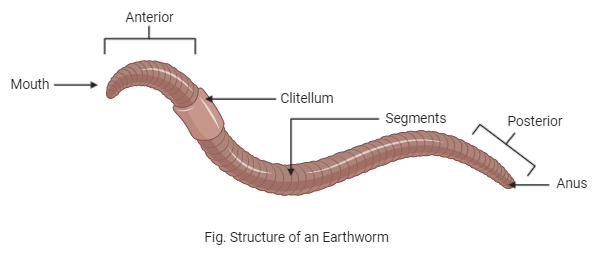
Locomotion in earthworm is helped by
A. Setae
B. Coelomic fluid
C. Body wall musculature
D. All of the above
Answer
469.8k+ views
Hint: Earthworms are seen in the soil. They eat their way through the soil and injects organic matter into the soil while moving which increases the fertility of the soil. The movement of earthworms in the soil is due to small hair-like structures present on its body.
Complete answer:
Earthworms belong to the phylum Annelida. They are mostly seen in rainy seasons in sandy areas. They usually come out of the burrows at night time for the search of food. They have dark brown colour due to the presence of porphyrin pigment that protects the body of earthworms from bright light. The body of an earthworm does not have any muscles in it rather it is filled with a liquid substance that helps the earthworms to maintain their shape. The earthworm has a cylindrical shape of the body.

The body of an earthworm is made up of several ring-like structures that the earthworm can contract and extend again in order to move forward. While moving forward the earthworm pulls the forward end and fixes the back end to the soil and then it fixes the front end to the ground and pulls the back end forward. The inner side of the earthworm body has small hair-like bristles called setae which help the earthworm to grab the surface or soil it is moving on.
Hence, the correct answer is option (A).
Note: Earthworm cannot move or grip on a smooth surface, as it uses setae for the movement which can grab the surface for the movement. Earthworm also secretes a slimy substance to help in its movement which makes it easier for the earthworm to move on a rough and hard surface compared to the smooth ones.
Complete answer:
Earthworms belong to the phylum Annelida. They are mostly seen in rainy seasons in sandy areas. They usually come out of the burrows at night time for the search of food. They have dark brown colour due to the presence of porphyrin pigment that protects the body of earthworms from bright light. The body of an earthworm does not have any muscles in it rather it is filled with a liquid substance that helps the earthworms to maintain their shape. The earthworm has a cylindrical shape of the body.

The body of an earthworm is made up of several ring-like structures that the earthworm can contract and extend again in order to move forward. While moving forward the earthworm pulls the forward end and fixes the back end to the soil and then it fixes the front end to the ground and pulls the back end forward. The inner side of the earthworm body has small hair-like bristles called setae which help the earthworm to grab the surface or soil it is moving on.
Hence, the correct answer is option (A).
Note: Earthworm cannot move or grip on a smooth surface, as it uses setae for the movement which can grab the surface for the movement. Earthworm also secretes a slimy substance to help in its movement which makes it easier for the earthworm to move on a rough and hard surface compared to the smooth ones.
Recently Updated Pages
Master Class 9 General Knowledge: Engaging Questions & Answers for Success

Master Class 9 English: Engaging Questions & Answers for Success

Master Class 9 Science: Engaging Questions & Answers for Success

Master Class 9 Social Science: Engaging Questions & Answers for Success

Master Class 9 Maths: Engaging Questions & Answers for Success

Class 9 Question and Answer - Your Ultimate Solutions Guide

Trending doubts
State and prove Bernoullis theorem class 11 physics CBSE

Who built the Grand Trunk Road AChandragupta Maurya class 11 social science CBSE

1 ton equals to A 100 kg B 1000 kg C 10 kg D 10000 class 11 physics CBSE

State the laws of reflection of light

One Metric ton is equal to kg A 10000 B 1000 C 100 class 11 physics CBSE

Difference Between Prokaryotic Cells and Eukaryotic Cells




